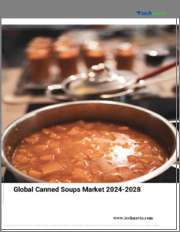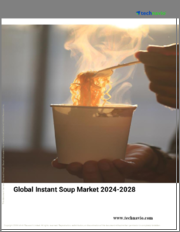
|
시장보고서
상품코드
1660749
건조 수프 시장 보고서 : 제품 유형별, 유형별, 생성별, 포장 유형별, 유통 채널별, 지역별(2025-2033년)Dried Soup Market Report by Product Type, Type, Preparation, Packaging Type, Distribution Channel, and Region 2025-2033 |
||||||
건조 수프 세계 시장 규모는 2024년에 129억 달러에 달했습니다. 향후 IMARC Group은 2033년에는 169억 달러에 도달하여 2025년부터 2033년까지 2.9%의 연평균 성장률(CAGR)을 기록할 것으로 예측하고 있습니다.
건조 수프는 탈수된 곡물, 채소, 육류에 각종 보존료와 향료를 첨가하여 만든 즉석 수프 믹스를 말합니다. 재료는 영양가에 영향을 주지 않고 수분을 제거하는 데 도움이 되는 동결건조 또는 저속 공기 건조 기술을 사용하여 탈수됩니다. 일반적으로 휴대가 간편한 컵이나 파우치에 담겨 있어 남녀노소 누구나 간편하게 한 끼 식사나 간식으로 즐길 수 있는 것이 특징입니다. 또한, 나트륨과 방부제가 많이 함유된 면류와 같은 다른 인스턴트 식품을 대체할 수 있는 영양가 높은 식품으로 널리 알려져 있습니다.
노동 인구의 증가와 바쁜 라이프스타일로 인해 균형 잡힌 영양가 있는 식사를 준비할 수 있는 시간이 점점 줄어들고 있습니다. 이에 따라 전 세계적으로 간편하고 바로 먹을 수 있는 식품에 대한 수요가 크게 증가하고 있습니다. 이러한 식품은 소비자의 영양적 요구와 다양한 기호를 모두 충족시킬 수 있습니다. 또한, 부가가치가 높은 무글루텐 및 유기농 건조 수프 제품군의 도입으로 제품 수요가 증가할 것으로 예상됩니다. 또한, 식료품점 및 편의점과 같은 조직화된 유통 채널의 확대와 여러 온라인 식료품 포털 사이트를 통해 제품에 대한 접근성이 향상되고 있습니다. 이와는 별도로, 필요한 영양 정보 및 기타 건강상의 이점을 담은 혁신적인 제품 포장도 소비자가 건조 수프를 구매하도록 설득하는 데 도움이 되고 있습니다. 다른 시장 성장요인으로는 가처분 소득과 지출 능력의 증가, 제조업체의 적극적인 판촉 활동을 들 수 있습니다.
본 보고서에서 다루는 주요 질문
- 세계 건조 수프 시장은 지금까지 어떻게 성장해왔고, 앞으로 어떻게 변화할 것인가?
- 세계 건조 수프 산업의 주요 지역 시장은?
- COVID-19는 세계 건조 수프 시장에 어떤 영향을 미쳤을까?
- 제품 유형별 시장 분석은?
- 생산별 시장 내역은?
- 유형별 시장 분석은?
- 포장 유형별 시장 분석은?
- 유통 채널별 시장 현황은?
- 세계 건조 수프 산업의 밸류체인에서 다양한 단계는 무엇인가?
- 세계 건조 수프 산업의 주요 촉진요인과 과제는 무엇인가?
- 세계 건조 수프 산업의 구조와 주요 업체는 무엇인가?
- 전 세계 건조 수프 산업의 경쟁 정도는?
- 전 세계 건조 수프 산업의 수익률은?
목차
제1장 서문
제2장 조사 범위와 조사 방법
- 조사 목적
- 이해관계자
- 데이터 소스
- 1차 정보
- 2차 정보
- 시장 추정
- 상향식 접근
- 하향식 접근
- 조사 방법
제3장 주요 요약
제4장 소개
- 개요
- 주요 업계 동향
제5장 세계의 건조 수프 시장
- 시장 개요
- 시장 실적
- COVID-19의 영향
- 시장 내역 : 제품 유형별
- 시장 내역 : 유형별
- 시장 내역 : 생성별
- 시장 내역 : 포장 유형별
- 시장 내역 : 유통 채널별
- 시장 내역 : 지역별
- 시장 예측
제6장 시장 내역 : 제품 유형별
- 건조 수프
- 시장 동향
- 시장 예측
- 인스턴트 건조 수프
- 시장 동향
- 시장 예측
제7장 시장 내역 : 유형별
- 베지테리언 수프
- 시장 동향
- 시장 예측
- 비베지테리언 수프
- 시장 동향
- 시장 예측
제8장 시장 내역 : 생성별
- 기존
- 시장 동향
- 시장 예측
- 유기농
- 시장 동향
- 시장 예측
제9장 시장 내역 : 포장 유형별
- 컵
- 시장 동향
- 시장 예측
- 파우치
- 시장 동향
- 시장 예측
- 기타
- 시장 동향
- 시장 예측
제10장 시장 내역 : 유통 채널별
- 슈퍼마켓과 하이퍼마켓
- 시장 동향
- 시장 예측
- 편의점
- 시장 동향
- 시장 예측
- 식료품점
- 시장 동향
- 시장 예측
- 직접 판매
- 시장 동향
- 시장 예측
- 온라인 스토어
- 시장 동향
- 시장 예측
- 기타
- 시장 동향
- 시장 예측
제11장 시장 내역 : 지역별
- 유럽
- 시장 동향
- 시장 예측
- 아시아태평양
- 시장 동향
- 시장 예측
- 북미
- 시장 동향
- 시장 예측
- 중동 및 아프리카
- 시장 동향
- 시장 예측
- 라틴아메리카
- 시장 동향
- 시장 예측
제12장 SWOT 분석
- 개요
- 강점
- 약점
- 기회
- 위협
제13장 밸류체인 분석
제14장 Porter's Five Forces 분석
- 개요
- 구매자의 교섭력
- 공급 기업의 교섭력
- 경쟁 정도
- 신규 참여업체의 위협
- 대체품의 위협
제15장 가격 분석
- 주요 가격 지표
- 가격 구조
- 마진 분석
제16장 경쟁 구도
- 시장 구조
- 주요 기업
- 주요 기업 개요
- Associated British Foods
- B&G Foods
- Baxters Food Group
- Campbell Soup
- Subo Foods
- Frontier Soups
- General Mills
- Hain Celestial
- House Foods Group
- Kraft Heinz
- Kroger
- Nestle
- Nissin Foods
- NK Hurst Company
- Unilever
- Premier Foods
The global dried soup market size reached USD 12.9 Billion in 2024. Looking forward, IMARC Group expects the market to reach USD 16.9 Billion by 2033, exhibiting a growth rate (CAGR) of 2.9% during 2025-2033.
Dried soup refers to an instant soup mix made by using dehydrated grains, vegetables and meat, along with various preservatives and flavoring agents. The ingredients are dehydrated using freeze-drying or slow air-drying techniques that help in removing the water content without affecting their nutritional value. It is usually available in portable cups and pouches and is relished by individuals of all age groups as a quick meal or snack option. Furthermore, it is widely considered as a more nutritious alternative to other instant food products such as noodles that usually contain a high amount of sodium and preservatives.
Rising working population and hectic lifestyles have left negligible time for preparing a balanced and nutritious meal. Consequently, the demand for convenience and ready-to-eat foods is experiencing a significant increase across the globe. These foods cater to both the nutritional needs and diversified tastes of consumers. Furthermore, the introduction of value-added gluten-free and organic variants of dried soup is expected to increase product demand. Additionally, the expansion of organized distribution channels such as grocery and convenience stores, along with several online grocery portals, has enhanced the product accessibility. Apart from this, innovative product packaging with the required nutritional information and other health benefits also helps in persuading the consumers to buy dried soup. Other factors contributing to the market growth include rising disposable income and expenditure capacity, along with aggressive promotional activities by manufacturers.
Key Market Segmentation:
Breakup by Product Type:
- Dehydrated Dried Soup
- Instant Dried Soup
Breakup by Type:
- Vegetarian Soup
- Non-Vegetarian Soup
Breakup by Preparation:
- Regular
- Organic
Breakup by Packaging Type:
- Cups
- Pouches
- Others
Breakup by Distribution Channel:
- Supermarkets and Hypermarkets
- Convenience Stores
- Grocery Stores
- Direct Sales
- Online Stores
- Others
Breakup by Region:
- Europe
- Asia Pacific
- North America
- Middle East and Africa
- Latin America
Competitive Landscape:
The report has also analysed the competitive landscape of the market with some of the key players being Associated British Foods, B&G Foods, Baxters Food Group, Campbell Soup, Subo Foods, Frontier Soups, General Mills, Hain Celestial, House Foods Group, Kraft Heinz, Kroger, Nestle, Nissin Foods, NK Hurst Company, Unilever, Premier Foods, etc.
Key Questions Answered in This Report:
- How has the global dried soup market performed so far and how will it perform in the coming years?
- What are the key regional markets in the global dried soup industry?
- What has been the impact of COVID-19 on the global dried soup market?
- What is the breakup of the market based on the product type?
- What is the breakup of the market based on the preparation?
- What is the breakup of the market based on the type?
- What is the breakup of the market based on the packaging type?
- What is the breakup of the market based on the distribution channel?
- What are the various stages in the value chain of the global dried soup industry?
- What are the key driving factors and challenges in the global dried soup industry?
- What is the structure of the global dried soup industry and who are the key players?
- What is the degree of competition in the global dried soup industry?
- What are the profit margins in the global dried soup industry?
Table of Contents
1 Preface
2 Scope and Methodology
- 2.1 Objectives of the Study
- 2.2 Stakeholders
- 2.3 Data Sources
- 2.3.1 Primary Sources
- 2.3.2 Secondary Sources
- 2.4 Market Estimation
- 2.4.1 Bottom-Up Approach
- 2.4.2 Top-Down Approach
- 2.5 Forecasting Methodology
3 Executive Summary
4 Introduction
- 4.1 Overview
- 4.2 Key Industry Trends
5 Global Dried Soup Market
- 5.1 Market Overview
- 5.2 Market Performance
- 5.3 Impact of COVID-19
- 5.4 Market Breakup by Product Type
- 5.5 Market Breakup by Type
- 5.6 Market Breakup by Preparation
- 5.7 Market Breakup by Packaging Type
- 5.8 Market Breakup by Distribution Channel
- 5.9 Market Breakup by Region
- 5.10 Market Forecast
6 Market Breakup by Product Type
- 6.1 Dehydrated Dried Soup
- 6.1.1 Market Trends
- 6.1.2 Market Forecast
- 6.2 Instant Dried Soup
- 6.2.1 Market Trends
- 6.2.2 Market Forecast
7 Market Breakup by Type
- 7.1 Vegetarian Soup
- 7.1.1 Market Trends
- 7.1.2 Market Forecast
- 7.2 Non-Vegetarian Soup
- 7.2.1 Market Trends
- 7.2.2 Market Forecast
8 Market Breakup by Preparation
- 8.1 Regular
- 8.1.1 Market Trends
- 8.1.2 Market Forecast
- 8.2 Organic
- 8.2.1 Market Trends
- 8.2.2 Market Forecast
9 Market Breakup by Packaging Type
- 9.1 Cups
- 9.1.1 Market Trends
- 9.1.2 Market Forecast
- 9.2 Pouches
- 9.2.1 Market Trends
- 9.2.2 Market Forecast
- 9.3 Others
- 9.3.1 Market Trends
- 9.3.2 Market Forecast
10 Market Breakup by Distribution Channel
- 10.1 Supermarkets and Hypermarkets
- 10.1.1 Market Trends
- 10.1.2 Market Forecast
- 10.2 Convenience Stores
- 10.2.1 Market Trends
- 10.2.2 Market Forecast
- 10.3 Grocery Stores
- 10.3.1 Market Trends
- 10.3.2 Market Forecast
- 10.4 Direct Sales
- 10.4.1 Market Trends
- 10.4.2 Market Forecast
- 10.5 Online Stores
- 10.5.1 Market Trends
- 10.5.2 Market Forecast
- 10.6 Others
- 10.6.1 Market Trends
- 10.6.2 Market Forecast
11 Market Breakup by Region
- 11.1 Europe
- 11.1.1 Market Trends
- 11.1.2 Market Forecast
- 11.2 Asia Pacific
- 11.2.1 Market Trends
- 11.2.2 Market Forecast
- 11.3 North America
- 11.3.1 Market Trends
- 11.3.2 Market Forecast
- 11.4 Middle East and Africa
- 11.4.1 Market Trends
- 11.4.2 Market Forecast
- 11.5 Latin America
- 11.5.1 Market Trends
- 11.5.2 Market Forecast
12 SWOT Analysis
- 12.1 Overview
- 12.2 Strengths
- 12.3 Weaknesses
- 12.4 Opportunities
- 12.5 Threats
13 Value Chain Analysis
14 Porters Five Forces Analysis
- 14.1 Overview
- 14.2 Bargaining Power of Buyers
- 14.3 Bargaining Power of Suppliers
- 14.4 Degree of Competition
- 14.5 Threat of New Entrants
- 14.6 Threat of Substitutes
15 Price Analysis
- 15.1 Key Price Indicators
- 15.2 Price Structure
- 15.3 Margin Analysis
16 Competitive Landscape
- 16.1 Market Structure
- 16.2 Key Players
- 16.3 Profiles of Key Players
- 16.3.1 Associated British Foods
- 16.3.2 B&G Foods
- 16.3.3 Baxters Food Group
- 16.3.4 Campbell Soup
- 16.3.5 Subo Foods
- 16.3.6 Frontier Soups
- 16.3.7 General Mills
- 16.3.8 Hain Celestial
- 16.3.9 House Foods Group
- 16.3.10 Kraft Heinz
- 16.3.11 Kroger
- 16.3.12 Nestle
- 16.3.13 Nissin Foods
- 16.3.14 NK Hurst Company
- 16.3.15 Unilever
- 16.3.16 Premier Foods

















